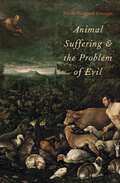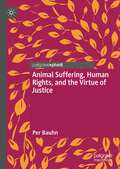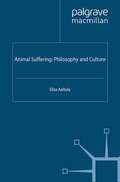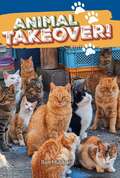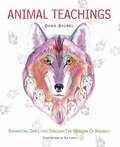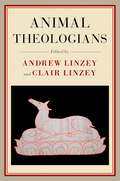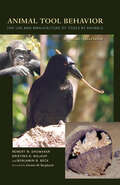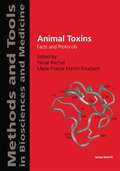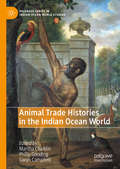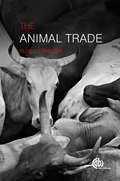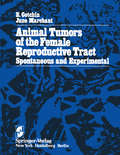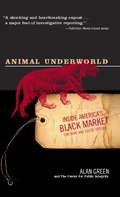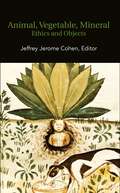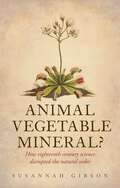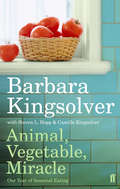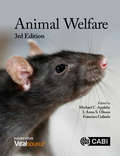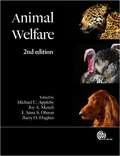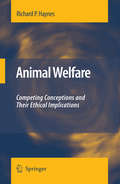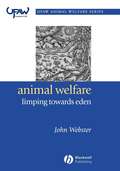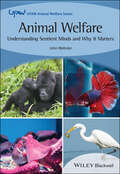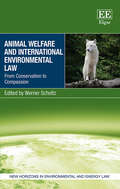- Table View
- List View
Animal Suffering and the Problem of Evil
by Nicola Hoggard CreeganNicola Hoggard Creegan offers a compelling examination of the problem of evil in the context of animal suffering, disease, and extinction and the violence of the evolutionary process. Using the parable of the wheat and the tares as a hermeneutical lens for understanding the tragedy and beauty of evolutionary history, she shows how evolutionary theory has deconstructed the primary theodicy of historic Christianity-the Adamic fall-while scientific research on animals has increased appreciation of animal sentience and capacity for suffering. Animal Suffering and the Problem of Evil responds to this new theodic challenge. Hoggard Creegan argues that nature can be understood as an interrelated mix of the perfect and the corrupted: the wheat and the tares. At times the good is glimpsed, but never easily or unequivocally. She then argues that humans are not to blame for all evil because so much evil preceded human becoming. Finally, she demonstrates that faith requires a confidence in the visibility of the work of God in nature, regardless of how infinitely subtle and almost hidden it is, affirming that there are ways of perceiving the evolutionary process beyond that "nature is red in tooth and claw."
Animal Suffering: Philosophy and Culture (The Palgrave Macmillan Animal Ethics Series)
by E. AaltolaExploring how animal suffering is made meaningful within Western ramifications, the book investigates themes such as skepticism concerning non-human experience, cultural roots of compassion, and contemporary approaches to animal ethics. At its center is the pivotal question: What is the moral significance of animal suffering?
Animal Teachings: Enhancing our lives through the wisdom of animals
by Dawn BrunkeIn this insightful book, Dawn Brunke reveals how animals can help us to uncover the wisdom we have forgotten. In Animal Teachings, she groups 60 species by their specific teaching - from how to find balance and be a better communicator to being more intuitive and living a joyous life. For example, Fox, Swan and Zebra are united through the teaching of Integration. All three species can help us learn to welcome diversity, reconcile opposites and maintain individuality. Meanwhile, the teaching of Healing unites Dog, Frog and Gorilla, who teach us love and loyalty, gentleness and how to connect to our deeper self. Every entry explores the presence of that species in the natural world and its traditional teaching as it is known through myth and legend or by indigenous peoples. In addition, each group presents a personalised message for humans today: encouragement, suggestions and guidance to help us become more conscious and whole. By opening to animal wisdom, we begin to find ways to reconnect, to deepen, to communicate, to love and to more joyfully participate in the dance of life. With the help of animals, we begin to remember who we really are.
Animal Theologians
by Andrew Linzey and Clair LinzeyMany people who have thought about God have not thought about animals, or about the relationship between the two. But among those who have are some of the most celebrated religious thinkers, including Michel de Montaigne, Thomas Tryon, John Wesley, John Ruskin, Leo Tolstoy, Mohandas K. Gandhi, Albert Schweitzer, and Paul Tillich. This volume comprises 24 scholarly studies that detail challenges to the dominant anthropocentrism of most religious traditions. The editors have brought together Jewish, Unitarian, Christian, transcendentalist, Muslim, Hindu, Dissenting, deist, and Quaker voices, each offering a unique theological perspective that counters the neglect of the nonhuman. Animal Theologians is divided into three parts starting with the pioneers who first saw a relationship between animals and divinity, those who contributed to the expansion of social sensibility to animals, and ending with the work of contemporary theologians. The essays in this volume use contextual and historical background to describe what led animal theologians to their beliefs, and then pave way for further developments in this expanding field. This volume is an act of reclaiming different religious traditions for animals by recovering lost voices.
Animal Theologians
Many people who have thought about God have not thought about animals, or about the relationship between the two. But among those who have are some of the most celebrated religious thinkers, including Michel de Montaigne, Thomas Tryon, John Wesley, John Ruskin, Leo Tolstoy, Mohandas K. Gandhi, Albert Schweitzer, and Paul Tillich. This volume comprises 24 scholarly studies that detail challenges to the dominant anthropocentrism of most religious traditions. The editors have brought together Jewish, Unitarian, Christian, transcendentalist, Muslim, Hindu, Dissenting, deist, and Quaker voices, each offering a unique theological perspective that counters the neglect of the nonhuman. Animal Theologians is divided into three parts starting with the pioneers who first saw a relationship between animals and divinity, those who contributed to the expansion of social sensibility to animals, and ending with the work of contemporary theologians. The essays in this volume use contextual and historical background to describe what led animal theologians to their beliefs, and then pave way for further developments in this expanding field. This volume is an act of reclaiming different religious traditions for animals by recovering lost voices.
Animal Tool Behavior: The Use and Manufacture of Tools by Animals
by Benjamin B. Beck Robert W. Shumaker Kristina R. WalkupWhen published in 1980, Benjamin B. Beck’s Animal Tool Behavior was the first volume to catalog and analyze the complete literature on tool use and manufacture in non-human animals. Beck showed that animals—from insects to primates—employed different types of tools to solve numerous problems. His work inspired and energized legions of researchers to study the use of tools by a wide variety of species.In this revised and updated edition of the landmark publication, Robert W. Shumaker and Kristina R. Walkup join Beck to reveal the current state of knowledge regarding animal tool behavior. Through a comprehensive synthesis of the studies produced through 2010, the authors provide an updated and exact definition of tool use, identify new modes of use that have emerged in the literature, examine all forms of tool manufacture, and address common myths about non-human tool use. Specific examples involving invertebrates, birds, fish, and mammals describe the differing levels of sophistication of tool use exhibited by animals.
Animal Toxins: Facts and Protocols (Methods and Tools in Biosciences and Medicine)
by Herve Rochat Marie-France Martin-EauclaireThis manual surveys toxins from insects, spiders, mollusks, fish, and snakes which have biotechnological applications. It reviews aspects of toxin origin, their molecular mechanism, and their cellular and pathogenic effects. It also provides methodology for the application of these toxins in the research laboratory. This includes a description of the extraction methods, biochemical characterization, and applications in pharmacological studies.
Animal Trade Histories in the Indian Ocean World (Palgrave Series in Indian Ocean World Studies)
by Martha Chaiklin Gwyn Campbell Philip GoodingThis book examines trades in animals and animal products in the history of the Indian Ocean World (IOW). An international array of established and emerging scholars investigate how the roles of equines, ungulates, sub-ungulates, mollusks, and avians expand our understandings of commerce, human societies, and world systems. Focusing primarily on the period 1500-1900, they explore how animals and their products shaped the relationships between populations in the IOW and Europeans arriving by maritime routes. By elucidating this fundamental yet under-explored aspect of encounters and exchanges in the IOW, these interdisciplinary essays further our understanding of the region, the environment, and the material, political and economic history of the world.
Animal Trade, The: Evolution, Ethics and Implications
by Clive PhillipsTrade is an inevitable part of human activity and evolution, but when it involves animals there are important ethical issues that have to be considered. Animal trade is often for economic reasons only, and may be hard to justify ethically. There are significant welfare and environmental costs to animals and human society that must be carefully evaluated before such a trade is sanctioned. Controversial and thought-provoking, this text focuses on the trade in live and dead animals and animal parts. It examines the facts and figures to quantify the scope of the animal trade, concentrating mainly on farm animals, but also covering captive wildlife and companion animals. The book describes welfare, environmental, economic and cultural issues around this trade, debating important ethical considerations for everyone that uses or is otherwise involved with animals, especially people in animal welfare.
Animal Tumors of the Female Reproductive Tract: Spontaneous and Experimental
by E. Cotchin J. MarchantThe chapters which comprise this book were prepared as part of a medical text, Pathology of the Female Genital Tract, which is intended for the obstetrician, gynecologist, and medical pathologist. In that context, we were con cerned to bring out the importance of the study of tumors of the female reproductive tract of animals, both as show ing the variety of spontaneous neoplasms that might affect the tract and as providing tumors capable of experimental reproduction. These chapters are published separately, since they contain information which may appeal to a range of readers who might not necessarily wish to acquire the full medical text-for example, to veterinary and comparative pathologists, cancer research workers, research workers in gynecology, experimental pathologists and endocrinologists, and possibly to others using animals in experimental and pharmaceutical studies. The survey of spontaneous tumors of the female repro ductive tract is largely concerned with tumors of the ovaries and uterus of domesticated animals, but attention is also given to laboratory animals, wild animals, and animals in zoos. The spontaneous tumors are well worth studying, not only because of their obvious clinical impor tance to veterinarians, but also because they might provide a stimulus for epidemiologic, etiologic, biologic, and ther apeutic investigations that may elucidate some of the problems related to their counterparts in humans.
Animal Underworld: Inside America's Black Market for Rare and Exotic Species
by Alan GreenA vast and previously undisclosed underground economy exists in the United States. The products bought and sold: animals. In Animal Underworld, veteran investigative journalist Alan Green exposes the sleazy, sometimes illegal web of those who trade in rare and exotic creatures. Green and The Center for Public Integrity reveal which American zoos and amusement parks dump their "surplus" animals on the middlemen adept at secretly redirecting them into the private pet trade. We're taken to exotic-animal auctions, where the anonymous high bidders are often notorious dealers, hunting-ranch proprietors, and profit-minded charlatans masquerading as conservationists. We visit some of the nation's most prestigious universities and research laboratories, whose diseased monkeys are "laundered" through this same network of breeders and dealers until they finally reach the homes of unsuspecting pet owners. And we meet the men and women who make their living by skirting through loopholes in the law, or by ignoring the law altogether. For anyone who cares about animals; for pet owners, zoo-goers, wildlife conservationists, and animal welfare advocates, Animal Underworld is gripping, shocking reading.
Animal Underworld: Inside America's Black Market for Rare and Exotic Species
by Alan GreenA vast and previously undisclosed underground economy exists in the United States. The products bought and sold: animals. In Animal Underworld, veteran investigative journalist Alan Green exposes the sleazy, sometimes illegal web of those who trade in rare and exotic creatures. Green and The Center for Public Integrity reveal which American zoos and amusement parks dump their "surplus" animals on the middlemen adept at secretly redirecting them into the private pet trade. We're taken to exotic-animal auctions, where the anonymous high bidders are often notorious dealers, hunting-ranch proprietors, and profit-minded charlatans masquerading as conservationists. We visit some of the nation's most prestigious universities and research laboratories, whose diseased monkeys are "laundered" through this same network of breeders and dealers until they finally reach the homes of unsuspecting pet owners. And we meet the men and women who make their living by skirting through loopholes in the law, or by ignoring the law altogether. For anyone who cares about animals; for pet owners, zoo-goers, wildlife conservationists, and animal welfare advocates, Animal Underworld is gripping, shocking reading.
Animal, Vegetable, Mineral: Ethics and Objects
by Jeffrey Jerome CohenAnimal, Mineral, Vegetable examines what happens when we cease to assume that only humans exert agency. Through a careful examination of medieval, early modern and contemporary lifeworlds, these essays collectively argue against ecological anthropocentricity. Sheep, wolves, camels, flowers, chairs, magnets, landscapes, refuse and gems are more than mere objects. They act; they withdraw; they make demands; they connect within lively networks that might foster a new humanism, or that might proceed with indifference towards human affairs. Through what ethics do we respond to these activities and forces? To what futures do these creatures and objects invite us, especially when they appear within the texts and cultures of the “distant” past?
Animal, Vegetable, Mineral?: How eighteenth-century science disrupted the natural order
by Susannah GibsonSince the time of Aristotle, there had been a clear divide between the three kingdoms of animal, vegetable, and mineral. But by the eighteenth century, biological experiments, and the wide range of new creatures coming to Europe from across the world, challenged these neat divisions. Abraham Trembley found that freshwater polyps grew into complete individuals when cut. This shocking discovery raised deep questions: was it a plant or an animal? And this was not the only conundrum. What of coral? Was it a rock or a living form? Did plants have sexes, like animals? The boundaries appeared to blur. And what did all this say about the nature of life itself? Were animals and plants soul-less, mechanical forms, as Descartes suggested? The debates raging across science played into some of the biggest and most controversial issues of Enlightenment Europe. In this book, Susannah Gibson explains how a study of pond slime could cause people to question the existence of the soul; observation of eggs could make a man doubt that God had created the world; how the discovery of the Venus fly-trap was linked to the French Revolution; and how interpretations of fossils could change our understanding of the Earth's history. Using rigorous historical research, and a lively and readable style, this book vividly captures the big concerns of eighteenth-century science. And the debates concerning the divisions of life did not end there; they continue to have resonances in modern biology.
Animal, Vegetable, Mineral?: How eighteenth-century science disrupted the natural order
by Susannah GibsonSince the time of Aristotle, there had been a clear divide between the three kingdoms of animal, vegetable, and mineral. But by the eighteenth century, biological experiments, and the wide range of new creatures coming to Europe from across the world, challenged these neat divisions. Abraham Trembley found that freshwater polyps grew into complete individuals when cut. This shocking discovery raised deep questions: was it a plant or an animal? And this was not the only conundrum. What of coral? Was it a rock or a living form? Did plants have sexes, like animals? The boundaries appeared to blur. And what did all this say about the nature of life itself? Were animals and plants soul-less, mechanical forms, as Descartes suggested? The debates raging across science played into some of the biggest and most controversial issues of Enlightenment Europe. In this book, Susannah Gibson explains how a study of pond slime could cause people to question the existence of the soul; observation of eggs could make a man doubt that God had created the world; how the discovery of the Venus fly-trap was linked to the French Revolution; and how interpretations of fossils could change our understanding of the Earth's history. Using rigorous historical research, and a lively and readable style, this book vividly captures the big concerns of eighteenth-century science. And the debates concerning the divisions of life did not end there; they continue to have resonances in modern biology.
Animal, Vegetable, Miracle: Our Year of Seasonal Eating
by Barbara Kingsolver"We wanted to live in a place that could feed us: where rain falls, crops grow, and drinking water bubbles up right out of the ground."Barbara Kingsolver opens her home to us, as she and her family attempt a year of eating only local food, much of it from their own garden. Inspired by the flavours and culinary arts of a local food culture, they explore many a farmers market and diversified organic farms at home and across the country. With characteristic warmth, Kingsolver shows us how to put food back at the centre of the political and family agenda. Animal, Vegetable, Miracle is part memoir, part journalistic investigation, and is full of original recipes that celebrate healthy eating, sustainability and the pleasures of good food.
Animal Welfare
by Michael Appleby Richard Bennett Dominique Blache Alain Boissy Charlotte C. Burn Dr Andrew Butterworth Michael Cockram Grahame Coleman Richard B D’Eath Ian J.H. Duncan Professor Cathy M Dwyer Paul Flecknell David Fraser Francisco Galindo Paul Hemsworth Stella Maris Huertas Barry Hughes Bryan Jones Linda Keeling Joergen B. Kjaer Ute Knierim Ilias Kyriazakis Shane K. Maloney Georgia Mason Joy Mench Professor Michael Mendl Ruth C Newberry Christine Nicol Birte L. Nielsen Anna Olsson Edmond A. Pajor Clare Palmer Jeffrey Rushen Peter Sandøe Sally L. Sherwen Marek Spinka Claudia Terlouw Paul Thompson Bert Tolkamp Ignacio Viñuela-Fernández Natalie K. Waran Daniel M Weary Francoise Wemelsfelder Nadja Wielebnowski Hanno Würbel Paul HockingUpdated and revised, this bestselling textbook continues to provide a broad introduction to the key topics in the welfare of animals both large and small, farm and companion, wild and zoo. It retains all the popular features of the previous editions with coverage of key issues such as ethics, animal pain and injury, health and disease, social conditions, and welfare dilemmas and problems. Importantly, it also offers practical advice for welfare assessment, with a full section dedicated to the implementation of solutions. The third edition: - Contains many more examples of welfare issues in different countries, particularly the implications for smallholders as well as larger scale agriculture - Covers fish welfare as well as welfare of amphibians, reptiles and invertebrates - Includes concepts of positive emotion and other positive aspects of welfare - Focuses on animal welfare and sustainability - Includes an integrated ebook with additional material and videos With contributions from renowned international experts and a new editorial team, Animal Welfare, 3rd Edition is an essential resource for students and researchers in animal and veterinary sciences and other disciplines considering the science and practice of animal welfare, and for practitioners and decision-makers worldwide.
Animal Welfare
by Michael C. Appleby Barry O. Hughes Joy A. Mench I. Anna S. OlssonThe welfare of animals continues to increase in recognition and concern throughout the world, with more and more research in the field offering new insights into the optimal conditions and treatment for the animals we live and work with. Providing a broad introduction to the key topics in the welfare of animals large and small, farm and companion, wild and zoo, this fully updated textbook covers ethics, animal pain and injury, health and disease and social conditions, welfare issues and problems, their assessment, and solutions. With contributions from renowned international experts Animal Welfare, 2nd Edition is an essential resource for students and researchers in animal and veterinary sciences.
Animal Welfare: Competing Conceptions And Their Ethical Implications
by Richard P. HaynesMembers of the “animal welfare science community”, which includes both scientists and philosophers, have illegitimately appropriated the concept of animal welfare by claiming to have given a scientific account of it that is more objectively valid than the more “sentimental” account given by animal liberationists. This strategy has been used to argue for merely limited reform in the use of animals. This strategy was initially employed as a way of “sympathetically” responding to the abolitionist claims of anti-vivisectionists, who objected to the use of animals in research. It was subsequently used by farm animal scientists. The primarily reformist (as opposed to abolitionist) goals of this community make the false assumption that there are conditions under which animals may be raised and slaughtered for food or used as models in scientific research that are ethically acceptable. The tendency of the animal welfare science community is to accept this assumption as their framework of inquiry, and thus to discount certain practices as harmful to the interests of the animals that they affect. For example, animal welfare is conceptualized is such a way that death does not count as harmful to the interests of animal, nor prolonged life a benefit.
Animal Welfare: A Practical Approach to Redressing the Problem of Our Dominion Over the Animals
by John WebsterThere has been a recent explosion of active concern in matters of animal welfare. The science behind animal welfare has progressed significantly, new codes of practice and legislation have come into to being, and innovative methods to assess welfare schemes for food production have emerged. Part of a major animal welfare series, Animal Welfare: Limping Towards Eden is John Webster’s new and groundbreaking work on animal welfare. Building on his first book, the highly acclaimed Animal Welfare: A Cool Eye Towards Eden, it not only critically reviews areas of development, but looks to how animal welfare can be improved in the future. Special consideration is given to: Defining animal welfare (‘fit and happy’) and establishing a systematic approach for its evaluation (the ‘five freedoms’); Providing a sound ethical framework that affords proper respect to animals within the broader context of our duties as citizens to the welfare of society; Developing comprehensive, robust protocols for assessing animal welfare and the provisions that constitute good husbandry; Introducing an education policy that will increase human awareness of animal welfare problems and promote action to reduce suffering. This book is part of the UFAW/Wiley-Blackwell Animal Welfare Book Series. This major series of books produced in collaboration between UFAW (The Universities Federation for Animal Welfare), and Wiley-Blackwell provides an authoritative source of information on worldwide developments, current thinking and best practice in the field of animal welfare science and technology. For details of all of the titles in the series see www.wiley.com/go/ufaw.
Animal Welfare: Understanding Sentient Minds and Why It Matters (UFAW Animal Welfare)
by John WebsterAnimal Welfare An Accessible Overview of the Concept of Sentience Throughout the Animal Kingdom and Why It Matters to Humans Animal Welfare explores the concept of sentience and the development of sentient minds throughout the animal kingdom. The work provides improved definitions and analysis of the ideas of sentience, cognition, and consciousness, along with evidence of advanced mental formulation in birds, fish, and invertebrates. Considerations between humans and animals are also discussed, such as outcome-based ethics in relation to humans’ duties of care and the rights and wrongs of domestication. The work is divided into three parts and covers key topics such as: Specifics of animal sentience, from pain and suffering, to fear and dread, all the way to animals’ social life and the comfort/joy/hope/despair they experience What we know about the sentience of different classes of animals in the waters, air, savannah/plains, and forests Considerations on human interactions based on animal sentience, including death (killing), animal farms, animals in laboratories, wild animals in captivity, and animals in sports and entertainment Analysis on what humans can learn from animals based on what we know about their varying levels of sentience Animal Welfare serves as an invaluable analysis of animal sentience for students, teachers, and professionals directly involved in the study, teaching, and applications of animal behavior, motivation, and welfare. Thanks to the wide-ranging implications of animal sentience, the work will also appeal to everyone with a broader interest in animal behavior and human/animal interactions.
Animal Welfare: Understanding Sentient Minds and Why It Matters (UFAW Animal Welfare #3)
by John WebsterAnimal Welfare An Accessible Overview of the Concept of Sentience Throughout the Animal Kingdom and Why It Matters to Humans Animal Welfare explores the concept of sentience and the development of sentient minds throughout the animal kingdom. The work provides improved definitions and analysis of the ideas of sentience, cognition, and consciousness, along with evidence of advanced mental formulation in birds, fish, and invertebrates. Considerations between humans and animals are also discussed, such as outcome-based ethics in relation to humans’ duties of care and the rights and wrongs of domestication. The work is divided into three parts and covers key topics such as: Specifics of animal sentience, from pain and suffering, to fear and dread, all the way to animals’ social life and the comfort/joy/hope/despair they experience What we know about the sentience of different classes of animals in the waters, air, savannah/plains, and forests Considerations on human interactions based on animal sentience, including death (killing), animal farms, animals in laboratories, wild animals in captivity, and animals in sports and entertainment Analysis on what humans can learn from animals based on what we know about their varying levels of sentience Animal Welfare serves as an invaluable analysis of animal sentience for students, teachers, and professionals directly involved in the study, teaching, and applications of animal behavior, motivation, and welfare. Thanks to the wide-ranging implications of animal sentience, the work will also appeal to everyone with a broader interest in animal behavior and human/animal interactions.
Animal Welfare and International Environmental Law: From Conservation to Compassion (New Horizons in Environmental and Energy Law series)
by Werner ScholtzAt a time when the planet’s wildlife faces countless dangers, international environmental law continues to overlook its evolving welfare interests. This thought-provoking book provides a crucial exploration of how international environmental law must adapt to take account of the growing recognition of the intrinsic value of wildlife. Animal Welfare and International Environmental Law offers compelling and timely arguments in favour of wildlife’s inherent worth and proposes a progressive development of the law in response to its needs and interests. Taking into account recent trends in bioethics and conservation, these critical discussions of wildlife welfare have dramatic implications for the future of sustainable development and sustainable use. The book challenges assumptions by taking a perspective which decentres the needs of humans and instead emphasises the growing need to protect wildlife with compassion and care. This book will prove invaluable to both students and scholars of environmental law, animal law and international law more widely. It will also appeal to policymakers, legal scholars and NGOs dealing with the imminent needs of the earth’s wildlife.
